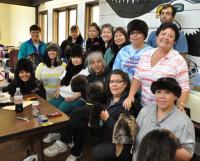IPinCH is supporting an innovative new project developed by the Sealaska Heritage Institute, which uses zooarchaeological research to protect cultural heritage values.
The new project — titled "Did Tlingit and Haida People eat sea otters during the pre-contact period? An issue of intellectual property and cultural heritage" — explores the history of sea otter use, through zooarchaeological study, in order to better understand the relationships between Tlingit ancestors and sea otters over the long period of time in which the two have been interacting. The project was developed by Chuck Smythe and Rosita Worl (SHI) and archaeologist Madonna L. Moss (University of Oregon), who will lead it.
The federal Marine Mammal Protection Act (MMPA, 1972) authorizes any Alaska Native who resides in Alaska and dwells on the coast of Alaska to harvest sea otters for subsistence purposes or the creation and sale of “authentic native articles of handicrafts and clothing” provided that the taking is not accomplished in a wasteful manner. Only Alaska Natives can buy and trade raw pelts or other sea otter parts between each other, and make and sell traditional handicrafts out of sea otter fur and other parts for sale to non-Natives. The MMPA does not define what are traditional subsistence uses of sea otters.
Some in the environmental community, who view the reintroduction and expansion of sea otters as one step in the restoration of the area’s marine ecosystem, believe that Tlingit should consume the animals as food in order for the harvesting of sea otters to not be considered wasteful. Contemporary Tlingit do not eat sea otter. By arguing that this condition should be met before Alaska Natives should be entitled to harvest sea otters, these environmentalists are attempting to define traditional Tlingit subsistence practices related to sea otter consumption. Who has the authority to define traditional subsistence use and who determines if a harvest is “wasteful”? Should not the Tlingit be the ones to define “subsistence purposes” according to their traditional practices? These are fundamental questions of indigenous cultural knowledge.
In their zeal to conserve sea otters, well-meaning regulators and environmentalists are on the cusp of placing additional restrictions on Alaska Native use of sea otters. Yet such negotiations are proceeding with virtually no consideration of the long-term history of the relationship of Tlingit people to sea otters. It seems likely that Tlingit people have been managing sea otters as part of larger marine ecosystems for thousands of years.
To better understand this history, Moss will travel to the Hearst Museum at University of California, Berkeley, which houses a significant collection of pre-contact sea otter bones from two sites (Daax Haat Kanadaa and Yaay Shanoow) in Southeast Alaska, to identify cut marks on the bones indicative of butchery and/or skinning.
Read more about this project >
Photo: Sealaska Heritage Institute's Sustainable Arts Program provides training to Southeast Alaska Natives in sewing sea otter skins to produce art for traditional use and for the sale of handicrafts. This program supports both cultural sustainability and cottage industries that allow tribal members to remain in their villages which have few economic opportunities and are characterized as economically depressed.






